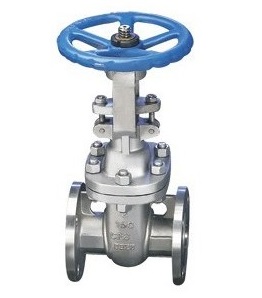- OCTG & Line Pipe
- Fittings
- Flanges
- Valves
- Rig Components & Tools
- Chemical Products
- Glacial Acetic Acid
- Toluene
- Xylene
- Acetone
- Ammonia Water
- Caustic Soda Liquid
- Cyclohexanone
- Dimethylformamide
- Epichlorohydrin
- Ethyl Acetate
- Formaldehyde
- Formic Acid
- Hydrochloric Acid
- Hydrogen Peroxide
- Methanol
- Methyl Ethyl Ketone
- Methyl Isobutyl Ketone
- Methylene Chloride
- N-butyl Acetate
- Nitric Acid
- Phenol
- Sulphuric Acid
- Trichloroethylene
- Personal Protective Equipment
A gate valve, also known as a sluice valve, is a valve that opens by lifting a round or rectangular gate/wedge out of the path of the fluid. The distinct feature of a gate valve is the sealing surfaces between the gate and seats are planar. The gate faces can form a wedge shape or they can be parallel. Typical gate valves should never be used for regulating flow, unless they are specifically designed for that purpose. On opening the gate valve, the flow path is enlarged in a highly nonlinear manner with respect to percent of opening. This means that flow rate does not change evenly with stem travel. Also, a partially open gate disk tends to vibrate from the fluid flow. Most of the flow change occurs near shutoff with a relatively high fluid velocity causing disk and seat wear and eventual leakage if used to regulate flow. Typical gate valves are designed to be fully opened or closed. When fully open, the typical gate valve has no obstruction in the flow path, resulting in very low friction loss.

●Size:
2"-56"●Pressure Rating:
Class 150 / Class 300 / Class 600 / Class 900 / Class 1500 / Class 2500●Material:
WCB/LCB/LCC/WC6/WC9/C5/CF8M/CF8/CF3M/CF3/CN7M●Specifications:
API 600, ASME/ANSI B16.34, BS 1414●End Connection:
RF / RTJ / BW●Disc Design:
Solid and Flexible Wedge●Stem:
Gate valves are characterized as having either a rising or a non-rising stem. Rising stems provide a visual indication of valve position. Non-rising stems are used where vertical space is limited or underground.●Bonnet:
Bonnets provide a leak proof closure for the valve body. Gate valves may have a screw-in, union, or bolted bonnet. Screw-in bonnets are the simplest design, offering a durable, pressure-tight seal. Union bonnets are suitable for applications requiring frequent inspection and cleaning. They also give the body added strength. Bolted bonnets are used for larger valves and higher pressure applications.
Another type of bonnet construction in a gate valve is a pressure seal bonnet. This construction is adopted for valves for high pressure service, typically in excess of 15 MPa (2250 psi). The unique feature about the pressure seal bonnet is that the body bonnet joint seals improve as the internal pressure in the valve increases, compared to other constructions where the increase in internal pressure tends to create leaks in the body-bonnet joint.
●Body-Bonnet Gasket
Carbon steel or stainless steel + flexible graphite combined gasket is used for Class150 gate valve; stainless steel + flexible graphite spiral wound gasket for Class 300 gate valve; stainless steel + flexible graphite spiral wound gasket for Class 600 gate valve, and ring type joint gasket is optional for Class 600 gate valve; ring type joint gasket is used for Class 900 gate valve; pressurized seal design is used for Class1500 to Class 2500 gate valve.
●Operation
Hand wheel or gearbox operator is usually applied, if required, chain wheel is available. Top flange dimension according to ISO 5211 is available for valves to be actuated.




